
“Yes, it all started out as a mild curiosity in a junkyard. And now it’s turned out to be quite a great spirit of adventure, don’t you think?”
Hello and welcome to ‘All of Time and Space’! In order to celebrate the premiere of the tenth modern season of ‘Doctor Who’, we at ScienceFiction.com thought it was the perfect time to kick off a new series examining the fifty-plus year history of the program. Starting with the very first season, aired in 1963, I will be taking a look back at every episode, with each installment covering an entire season. (Otherwise, I may never catch up!) I’m very excited to get underway, and hope you’ll stick around for the ride!
Before we jump into the season proper, I’d like to offer a brief history of ‘Doctor Who’. Unlike shows like ‘Star Trek’, where the genesis of the program can be traced to one man with an idea, ‘Doctor Who’ really benefitted from the many hands involved in its creation. While the individuals most directly responsible for the show taking the shape it did are Donald Wilson (then Head of Serials), Sydney Newman (then Head of Drama), and writer C.E. Webber, who jump started the development of a science fiction series alongside producer Verity Lambert (the first woman to hold the position at the BBC), who shepherded the show to the screen, refining the core of it from these early conceptual stages to the form that would quickly earn its place in the annals of pop culture history.
Originally developed with the aim of filling a teatime scheduling gap on Saturday evenings, the show was rather famously intended to feature an educational element, with the central conceit of a machine that can take our heroes any place at any time allowing them to include lessons on history in (you guessed it) the historical stories and on scientific principles in the more science fiction oriented episodes. Of course, that has long since fallen by the wayside, but what many may find striking is just how quickly they began to move away from that intent, at least with regard to the sci-fi stories The first such story without an identifiable “lesson” is only the fifth overall, and to be blunt even the third story’s claim to edutainment is tenuous at best. Unless you’ve always wanted to know how buttons work.
If you’re interested in a more in-depth look at the program’s development, there is an excellent documentary included with the DVD release of ‘The Edge of Destruction’ called ‘Doctor Who: Origins’. I cannot recommend it enough.
But enough of this. Let’s move on to the season!
An Unearthly Child
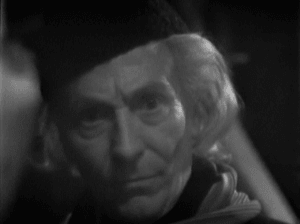 There’s something odd about Susan Foreman. She knows things she shouldn’t but has odd gaps when it comes to daily life. Their curiosity piqued, teachers Ian Chesterton and Barbara Wright follow her home, though the address leads to a scrap yard. There, they meet a strange, evasive old man. Thinking Susan trapped in a police box, there burst in, finding instead the sprawling control room of the TARDIS, which Susan explains can travel through time and space. The old man is revealed as the Doctor, Susan’s grandfather. Not feeling inclined to trust Ian and Barbara with the knowledge of his and Susan’s true nature as time travelers, he instead activates the TARDIS, effectively kidnapping the two teachers. The TARDIS then materializes in prehistoric times, and our motley crew of heroes is thrust into a power struggle among a tribe of cavemen. In this tribe, the most important man is the one who knows how to make fire. But since the previous firemaker’s death, Za (his son and heir apparent) has struggled to make fire. His claim to leadership is thus challenged by Kal, a newcomer and skilled hunter. Believing that the strangers (the TARDIS crew) have the secrets of fire, the tribe takes them prisoner. They escape and are recaptured. Eventually, Kal is exiled as punishment for murder, leaving Za unchallenged, save for his struggles with fire. When Ian finally manages to start a fire, Za decides they are too valuable to release, and so the prisoners stage another escape, this time making it all the way to the TARDIS, which carries them to their next adventure.
There’s something odd about Susan Foreman. She knows things she shouldn’t but has odd gaps when it comes to daily life. Their curiosity piqued, teachers Ian Chesterton and Barbara Wright follow her home, though the address leads to a scrap yard. There, they meet a strange, evasive old man. Thinking Susan trapped in a police box, there burst in, finding instead the sprawling control room of the TARDIS, which Susan explains can travel through time and space. The old man is revealed as the Doctor, Susan’s grandfather. Not feeling inclined to trust Ian and Barbara with the knowledge of his and Susan’s true nature as time travelers, he instead activates the TARDIS, effectively kidnapping the two teachers. The TARDIS then materializes in prehistoric times, and our motley crew of heroes is thrust into a power struggle among a tribe of cavemen. In this tribe, the most important man is the one who knows how to make fire. But since the previous firemaker’s death, Za (his son and heir apparent) has struggled to make fire. His claim to leadership is thus challenged by Kal, a newcomer and skilled hunter. Believing that the strangers (the TARDIS crew) have the secrets of fire, the tribe takes them prisoner. They escape and are recaptured. Eventually, Kal is exiled as punishment for murder, leaving Za unchallenged, save for his struggles with fire. When Ian finally manages to start a fire, Za decides they are too valuable to release, and so the prisoners stage another escape, this time making it all the way to the TARDIS, which carries them to their next adventure.
Honestly, I feel like I should have more to say about this one. It’s obviously hugely important, but the thing about this story is that it’s a study in contrasts. The first episode of the serial (and thus, of ‘Doctor Who’) is nothing short of fantastic. It’s engaging to the point that you can’t take your eyes off of it. But the other three episodes? Well, they’re not bad, but somehow three episodes focused on the political maneuvering of caveman society don’t exactly make for the most engaging viewing. It’s not exactly an auspicious start. Though it does establish the series’ tradition of spending a lot of time in caves, so there’s that.
The Daleks
The TARDIS arrives in a petrified and, unbeknownst to the crew, heavily irradiated forest on a seemingly barren planet. Upon investigating a nearby city, they are discovered and taken captive by its inhabitants: the Daleks! The TARDIS crew escapees meet the Thals, a considerably more welcoming race that is, like the Daleks, native to this world (which we learn is called Skaro). The Daleks have been seeking a way to render themselves immune to radiation in order to move beyond the boundaries of their city, but when they realize that they have evolved to depend on it, they decide to further irradiate the surface, exterminating the Thals in the process. Joining the Thals in a desperate incursion into the Dalek city, they are able to prevent the release of radiation and disable the Daleks’ power source, crippling them.
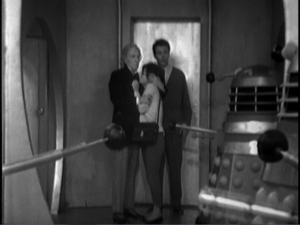 Now this is more like it! After a somewhat uneven start, this second serial is where ‘Doctor Who’ really starts to find its footing. Writer Terry Nation has a strong grasp on serialized storytelling, but as much of a boon as that is to the show, the real legacy of this story is, of course, the introduction of the titular villains. While it likely goes without saying that the Daleks have since become the Doctor’s signature nemeses, what cannot be overstated is just how quickly they took hold in the imaginations of the British public, as the sudden, massive ratings boost brought on by the early throes of Dalekmania is by many accounts responsible for securing the show’s place in the BBC’s lineup. Beyond the creatures, even the production design takes a step up in this story, as an alien world allows the team to flex their creative muscles rather more so than caves, caves and more caves (though this story also features caves). Of course, there is the design of the Daleks themselves, which is just striking and has barely changed in half a century. But even the design of the Dalek city is a work of subtle brilliance, with the slanted doorways, for example, providing just the right blend of the familiar and the alien.
Now this is more like it! After a somewhat uneven start, this second serial is where ‘Doctor Who’ really starts to find its footing. Writer Terry Nation has a strong grasp on serialized storytelling, but as much of a boon as that is to the show, the real legacy of this story is, of course, the introduction of the titular villains. While it likely goes without saying that the Daleks have since become the Doctor’s signature nemeses, what cannot be overstated is just how quickly they took hold in the imaginations of the British public, as the sudden, massive ratings boost brought on by the early throes of Dalekmania is by many accounts responsible for securing the show’s place in the BBC’s lineup. Beyond the creatures, even the production design takes a step up in this story, as an alien world allows the team to flex their creative muscles rather more so than caves, caves and more caves (though this story also features caves). Of course, there is the design of the Daleks themselves, which is just striking and has barely changed in half a century. But even the design of the Dalek city is a work of subtle brilliance, with the slanted doorways, for example, providing just the right blend of the familiar and the alien.
Unfortunately, with the story clocking in at seven episodes in length, we also get our first hint of the problems that often result from the preference that early ‘Doctor Who’ has for longer stories. While ‘The Daleks’ is mostly well paced, it nonetheless drags a bit in the latter stages, slowing down in part five and nearly grinding to a halt as part six spends half its runtime on crossing a single chasm. That being said, the seventh episode marks a return to form as the story draws to a close.
As good as it is though, this story can be especially jarring for modern viewers. Not only are the Daleks themselves less maniacally aggressive and more conniving than they would eventually become, but neither they nor the Doctor has any prior knowledge of the other. This is to say nothing of their reliance on static electricity and confinement to their city. And while they speak on several occasions of the “extermination” of the Thals, their famed shoutiness and predilection for chanting will come later. Overall, while these Daleks are menacing, they are hardly the galactic conquerors that we will come to know.
The Edge of Destruction
When the TARDIS suffers an in-flight malfunction, the Doctor suspects sabotage. As the travelers grow increasingly paranoid they begin to turn on each other, exacerbating the existing tensions between them. As they realize the gravity of the situation, the four are forced to work together to piece together the clues they are being given by the TARDIS itself. Finally, Ian and the Doctor locate the source of the malfunction: a broken spring in the fast return switch, preventing it from releasing itself. Out of danger at last, the Doctor, Ian, and Barbara finally bury the hatchet, effectively marking a fresh start for them all.
This almost more of an interlude than a full story. But its brevity (running a mere two episodes in length) certainly works in its favor as matters are resolved before the admittedly thin plot has a chance to wear out its welcome. The best moments of the story actually involve Barbara, who for the first time (but hardly the last) has had exactly enough of the Doctor’s nonsense and gives him a piece of her mind. ‘The Edge of Destruction is also central to the narrative arc of the season, as it marks the point at which Ian and Barbara’s relationship with the Doctor becomes less tense and more amicable.
Also, while it’s not explicitly stated, this story gives us our first indication that the TARDIS is both alive and psychic, as the events of the serial are ultimately traced to the TARDIS’s attempt to warn the travelers of a malfunction.
Marco Polo
The TARDIS lands on a frozen mountaintop and, in search of food and shelter that the once again malfunctioning ship cannot provide, the crew joins Marco Polo’s caravan on its journey to the court of Kublai Khan, but not before Marco seizes the TARDIS as a tribute for the Khan. On the journey they encounter many dangers, some due to the covert machinations of Tegana, a Mongol warlord ostensibly sent to make peace with Kublai Khan, but who is, in fact, plotting his assassination. Upon reaching the Khan’s court, the Doctor bonds with the monarch over how much it sucks to get old and Tegana makes his move in the face of mounting suspicion. When the Khan is saved, Marco at last returns the TARDIS and the Doctor and his companions waste no time in departing.
‘Marco Polo’ marks the show’s first pure historical, meaning a story in which the only science fiction elements are the main cast and the TARDIS itself. The story remains engaging despite its length, as the journey to Cathay introduces enough new locations and threats to keep the story from growing stale. The length and constant change in setting also afford the story an epic sweep that is unusual for ‘Doctor Who’ of this vintage. And as if that weren’t enough, the production design is truly remarkable, especially given the show’s famously tight budget.
Unfortunately, ‘Marco Polo’ also brings us to another first for ‘Doctor Who’: The first missing episodes. Due to the nature of both Equity contracts and British television in general in the 1960s, episodes of a television series would be recorded, broadcast, and only occasionally repeated. To put it another way, reruns were rare (only a certain number were contractually permitted) and the home video market wouldn’t even exist for about twenty years. So after a certain point, the master tapes of these episodes would simply be taking up space in the archive. Because of this, the tapes themselves came to be seen as more valuable than the material recorded on them, and most were wiped and reused. Because of this, many of the intact ‘Doctor Who’ episodes from this period survived due to overseas sales, and there remain several gaps in the archive. However, there are complete audio recordings of every episode, as well as telesnaps (photos taken of a TV screen as the episode was broadcast at the behest of the BBC). This has allowed for the reconstruction of missing episodes, most commonly in a form resembling a slideshow set to the surviving audio. The most widely distributed of these were produced by Loose Cannon, who were actually able to produce two different reconstructions for ‘Marco Polo’: a standard black and white telesnap reconstruction and a full color reconstruction from (among other sources) set photos. While I watched the black and white reconstruction for this review, I would very much recommend tracking down the color reconstruction, as it really highlights the effort that was put into the set and costume designs.
The Keys of Marinus
Upon arriving on the planet Marinus, the Doctor and his companions are recruited to recover the operating keys to a supercomputer called the Conscience of Marinus before the villainous Voord can get ahold of them. The quest takes them from the glass shores of an acid sea to an illusory city controlled by disembodied brains, a predatory jungle, a frozen mountain, and even a courtroom when Ian finds himself framed for murder. With Ian’s name cleared and the keys gathered, they return to the Conscience and find the Voord in control of the computer, needing only the final key to complete their victory. Ian tricks the Voord into using a fake key, which causes the Conscience to explode, destroying the Voord along with it.
For my money, ‘The Keys of Marinus’ is one of the strongest outings of the entire first season. Like ‘Marco Polo’, this story has an epic feel, but it achieves this in a different fashion. While ‘Marco Polo’ follows a journey from Point A to Point B, ‘The Keys of Marinus’ follows a quest that leaps to a new location with each episode. By giving us something fresh every episode, it both keeps the story from getting stale and plays to returning writer Terry Nation’s strengths in serialized storytelling. Beyond this, the variety of locations really helps ‘Marinus’ stand out from the pack. One of the reasons for the show’s serialized structure (not to mention its early preference for long stories) was that it made it easier to stretch the budget. After all, using the same sets for six episodes instead of one means that you’ve just freed up money that would otherwise be spent on five episodes’ worth of scenery. ‘The Keys of Marinus’ bucks that trend, and in fact looks as though a good deal of money was spent on it (at least by the stands of early ‘Doctor Who’).
The structure of this story (a new adventure every week, each playing into the larger quest) allows Barbara in particular to get several crowning moments of awesome throughout the serial, the most notable of which comes when she picks up an improvised club and goes to town on the disembodied brains that are trying to enslave her friends.
The Aztecs
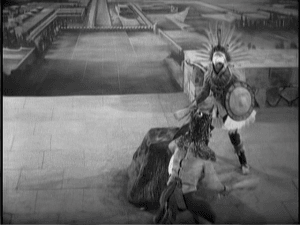 Materializing in an Aztec tomb, Barbara is mistaken for a goddess, Susan goes to Aztec school, Ian throws a guy off a pyramid, and the Doctor makes some cocoa and gets engaged. While acting as the goddess Yetaxa, Barbara attempts to use her influence to end the practice of human sacrifice, which puts her at odds with both the Doctor and Tlotoxl, the High Priest of Sacrifice. As Tlotoxl plots against Barbara and her “servants”, their position among the Aztecs becomes ever more tenuous, ultimately forcing them to leave as soon as they are able to return to the TARDIS, which has spent most of the story sealed in the tomb.
Materializing in an Aztec tomb, Barbara is mistaken for a goddess, Susan goes to Aztec school, Ian throws a guy off a pyramid, and the Doctor makes some cocoa and gets engaged. While acting as the goddess Yetaxa, Barbara attempts to use her influence to end the practice of human sacrifice, which puts her at odds with both the Doctor and Tlotoxl, the High Priest of Sacrifice. As Tlotoxl plots against Barbara and her “servants”, their position among the Aztecs becomes ever more tenuous, ultimately forcing them to leave as soon as they are able to return to the TARDIS, which has spent most of the story sealed in the tomb.
Alongside the previous serial, ‘The Aztecs’ easily ranks as one of the best the season has to offer. Part of this is no doubt due to the fact that it clocks in at a mere four episodes in length. Not only is this arguably the ideal length for a ‘Doctor Who’ story, it’s also honestly a nice break after a run of six- and seven-part stories.
Also, like ‘The Keys of Marinus’, ‘The Aztecs’ continues the trend of elevating the companions to new heights of badassery. This time, it’s Ian’s turn. While he hasn’t exactly been a slouch in this department, ‘The Aztecs’ really gives him a chance to shine. Even while drugged, he has a clear advantage in his duel with the trained warrior Ixta. And that’s two episodes before Ian throws him off a pyramid!
One of the more interesting elements of ‘The Aztecs’ is that after a fashion, Barbara is the villain. Tlotoxl may be the antagonist, but he’s not actually wrong. Barbara is a false god, after all, and one who is trying to alter deeply rooted elements of their culture at that. By the time the TARDIS crew leaves, she has meddled (unsuccessfully) in the local culture, disrupted their society, and inadvertently caused Autloc (the High Priest of Knowledge and her most steadfast ally) to lose his faith.
Also, anyone who thinks a romantic approach to the Doctor is a recent development owing to Paul McGann or David Tennant’s iterations of the character needs to revisit this story, as the Doctor charms and is even briefly engaged to Cameca, for whom he clearly bears some lingering fondness as the story ends.
And did I mention Ian throws a guy off a pyramid? Because Ian throws a guy off a pyramid, and he does it while dressed like a refugee from the Children’s Television Workshop.
The Sensorites
The TARDIS lands on a human spaceship held captive (and subject to intermittent psychic attacks) by the Sensorites. When the Sensorites board, they quickly prove less aggressive than expected and reveal to the Doctor that they refuse to allow the humans to leave their star system to keep secret the presence of a valuable mineral on their world. A group of humans learned this secret before, and the Sensorites have come blame them for the disease afflicting their people. On visiting the Sense Sphere (the Sensorites’ homeworld), Ian contracts the plague, leading the Doctor to realize that it is linked to a water source as he sets to work finding a cure. Meanwhile, they must also contend with the schemes of the xenophobic City Administrator. With the disease cured and the Administrator exposed, the TARDIS crew moves on and the audience breathes a sigh of relief.
The thing about ‘The Sensorites’ is that it’s not so much bad as it is dull. It has its moments, but it’s also longer than it needs to be and there are some points at which the serial is obviously padded (get used to that criticism). Remember how I said four episodes was the ideal length for Doctor Who stories? Yeah, about that… To this point, the longer stories (‘The Daleks,’ ‘Marco Polo,’ ‘The Keys of Marinus’) have for the most part been well paced. But ‘The Sensorites just drags. The story is at least two episodes too long and would have been far more effective had it been shorter. While I may have voiced similar issues with ‘The Daleks’ (namely the sixth episode, which devotes a shocking amount of time to minding the gap), that serial’s padding didn’t do nearly as much to drag it down as this one does. And it recovered fairly quickly, which ‘The Sensorites’ never really does.
And then there’s the Sensorites themselves. To the extent that they function as such, the Sensorites are not the most impressive villains. You see, the Sensorites are afraid of the dark, have trouble with the concept of object permanence, and are vulnerable to loud noises. Oh, and one of the City Administrator’s plans hinges on all Sensorites looking alike save for badges of office. Yes, really.
Notably, Susan gives a description of Gallifrey (though the world was still years away from being named) that would later be repeated almost word for word by the Tenth Doctor. New series fans may also recognize some elements of the Sensorites themselves in the Ood, for whom they provided a loose inspiration and serve as a cousin race (the Sense Sphere is said to be located in the same star system as the Ood Sphere).
The Reign of Terror
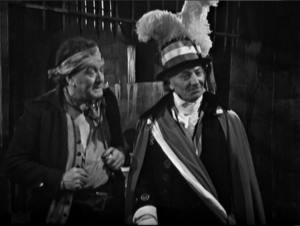 In a fit of pique, the Doctor decides to return Ian and Barbara back home. Of course, the TARDIS being the TARDIS, they find themselves on Earth but in Revolutionary France rather than 1960s England. Finding themselves in the wrong place at the wrong time, Barbara, Ian, and Susan are arrested and quickly sentenced to the guillotine. Meanwhile, the Doctor – who has been separated from his companions – makes his way to Paris, and on the way picks up the most amazing hat ever. Through luck and cunning, the companions are spared execution and become involved with an Underground Railroad for Robespierre’s would-be victims. As our heroes at last reunite and return to the TARDIS, Robespierre’s overthrow by Napoleon is just beginning, bringing the Reign of Terror to a close.
In a fit of pique, the Doctor decides to return Ian and Barbara back home. Of course, the TARDIS being the TARDIS, they find themselves on Earth but in Revolutionary France rather than 1960s England. Finding themselves in the wrong place at the wrong time, Barbara, Ian, and Susan are arrested and quickly sentenced to the guillotine. Meanwhile, the Doctor – who has been separated from his companions – makes his way to Paris, and on the way picks up the most amazing hat ever. Through luck and cunning, the companions are spared execution and become involved with an Underground Railroad for Robespierre’s would-be victims. As our heroes at last reunite and return to the TARDIS, Robespierre’s overthrow by Napoleon is just beginning, bringing the Reign of Terror to a close.
There’s not a lot to say here. Though ‘The Reign of Terror’ is a definite step up from ‘The Sensorites’, it is similarly a bit on the long side and uses what will become a familiar template of “the heroes get captured, they escape, they get captured again” to drive much of its action. At the end of the day, ‘The Reign of Terror’ is a fairly standard historical outing. It is by no means bad, but if you’ve watched ‘Marco Polo’ or ‘The Aztecs’, you’ve already seen this type of story done better. The story is significant as the first serial to feature location shooting (limited though it was), and also marked the first contribution to the program by writer Dennis Spooner, who would go one to contribute several notable stories and eventually serve as script editor.
Like ‘Marco Polo’, this story also includes some missing episodes. Unlike the earlier story, though, four of the six episodes are intact. ‘The Reign of Terror’ also benefits from its DVD release, which includes animated reconstructions of the missing episodes. Despite some occasionally awkward directing choices, the animation makes the reconstructed episodes much more engaging and overall easier to follow than the more conventional telesnap reconstructions.
Looking at the first season of ‘Doctor Who’ as a whole, it makes for a fairly strong start once it finds its footing, though it will also be a largely alien viewing experience to fans weaned in the era of David Tennant or Peter Capaldi.
We’ve already covered the stories, so let’s look at how the season handles its characters. Easily the most substantial character work in the season is given to William Hartnell as the Doctor. That may not be the most shocking thing, given that he is the title character, but if there’s one thing you realize while watching this season, it’s that even though the Doctor is the title character, Ian is arguably the series lead.
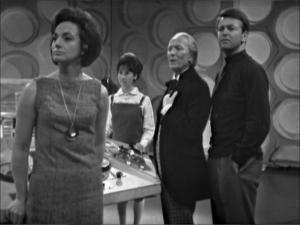 The Doctor’s character development is something that largely takes place in the background, as he evolves from an abrasive, ruthless character who is perfectly willing to bash in a caveman’s skull (Ian stops him), or dump his companions (who he effectively kidnapped in the first place) wherever the TARDIS happens to materialize next into a kinder, gentler Time Lord. Much of that development takes place as a direct result of his relationship with Ian and Barbara, and as he grows closer and more comfortable with his companions, his rough edges are smoothed out and he becomes a much more likeable character. Of course, he’s not above needling his friends, as one of the many traits of the First Doctor that would be adopted by Hartnell’s successors is his frequent and deliberate mangling of Ian Chesterton’s name (addressing him as everything from “Chartow” to “Chesterhouse”, in much the same way Christopher Eccleston’s Doctor would refer to Mickey as Ricky).
The Doctor’s character development is something that largely takes place in the background, as he evolves from an abrasive, ruthless character who is perfectly willing to bash in a caveman’s skull (Ian stops him), or dump his companions (who he effectively kidnapped in the first place) wherever the TARDIS happens to materialize next into a kinder, gentler Time Lord. Much of that development takes place as a direct result of his relationship with Ian and Barbara, and as he grows closer and more comfortable with his companions, his rough edges are smoothed out and he becomes a much more likeable character. Of course, he’s not above needling his friends, as one of the many traits of the First Doctor that would be adopted by Hartnell’s successors is his frequent and deliberate mangling of Ian Chesterton’s name (addressing him as everything from “Chartow” to “Chesterhouse”, in much the same way Christopher Eccleston’s Doctor would refer to Mickey as Ricky).
Ian and Barbara are both quite well handled overall. Each is well characterized and given plenty to do. And it’s especially satisfying that a good deal of that “plenty to do” involves kicking ass, taking names, and occasionally throwing people off of pyramids. And while the show still has a long way to go where it’s handling of female characters is concerned, Barbara makes for a surprisingly strong start. That said, Barbara’s handling in particular makes the show’s approach to Susan all the more frustrating. You see, with Susan, you never quite know what you’re going to get. Depending on the story, she may be a mysterious, intriguing figure (‘An Unearthly Child), an assertive young woman (‘The Sensorites’), or a shrinking violet who screams at the slightest provocation (‘The Reign of Terror’).
And with that, we bring our coverage of the first season of ‘Doctor Who’ to a close. I hope you’ll join us when we return in a few weeks to cover the second, which will begin the show’s long history of change…
